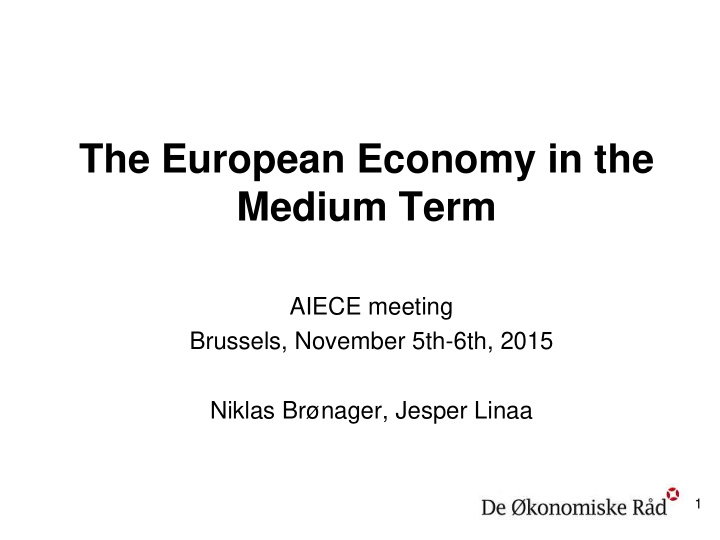



The European Economy in the Medium Term AIECE meeting Brussels, November 5th-6th, 2015 Niklas Brønager, Jesper Linaa 1
This report • Should have been worked out for the AIECE meeting in the spring of 2014 • Basically, we have used the same questionnaires as for the previous reports • Many AIECE institutes apparently do short-term forecasting only, so the results in this report are likely to overlap with those of the general report • Hence, the most interesting part of the report is probably about reform needs and the discussion about this • We start with a brief presentation followed by a discussion on selected topics 2
Progress in the euro area … Real GDP 2005Q1 = 100 110 108 106 104 102 100 98 2006 2008 2010 2012 2014 Source: Macrobond 3
.. but still the output gap is huge and negative Per cent of structural GDP 4 3 2 1 0 -1 -2 -3 -4 2006 2008 2010 2012 2014 Source: Macrobond 4
Projected GDP growth in the euro zone, 2015-20 Per cent per year 2.5 2.0 1.5 1.0 0.5 0.0 IFW NIER ETLA KEPE SN DOR NIESR GKI CEPREDE COE WIFO Source: AIECE institutes 5
Risk of secular stagnation appear significant Frequency 10 8 6 4 2 0 0-10% 11-25% 26-75% 76-90% 91-100% Source: AIECE institutes 6
… which is also visible in the ECB policy rate Per cent Expected average policy rate, 2015-20 2.5 2.0 1.5 1.0 0.5 0.0 BIPE DOR SKEP NIESR COE NIER Prometeia GKI Source: AIECE institutes 7
Weak investments reflect the weak economy • There is an emerging consensus amongst leading international institutions that – In many countries weak investments mainly reflect weak demand – Tight credit conditions, political uncertainty, and weak public investments do play a role but are not the decisive factor • The majority of AIECE institutes agree with this narrative • The immediate implication is that investments will increase along with the cyclical upswing. In most countries no specific initiatives are needed 8
Projected per capita GDP growth in, 2015-20 Source: AIECE institutes 9
Reform needs in the labour market • France and other countries struggle with high levels of structural unemployment caused by high minimum wages and inflexible layoff rules • Sweden has a growing mismatch problem. The high wage level makes it difficult for low-skilled workers to get jobs. Maybe also relevant in Denmark • UK and France needs to improve entry to the job market for young people by e.g. apprenticeships • Many countries need to improve job incentives for older people in order to stimulate labour supply • O 10
Reform needs in the pension system • Many European countries, including Germany , France , Poland , Slovenia , and Hungary , have not yet fully handled the demographic challenge. Some countries deem their pension system “unsustainable” • The current statutory retirement age is rather low in many countries… • … and more importantly; in many countries, the statutory retirement age is not linked to life expectancy 11
Various reform needs • Denmark , Sweden and the UK would benefit from larger automatic stabilizers for the housing market • Sweden report it needs to increase construction of new homes due to the inflow of refugees and immigrants. Maybe, this is also an issue in Denmark – and what about Germany ? • Poland needs to rebuilt the taxation system from scratch • German labour costs are high when including social contributions • Hungary , Slovenia and others have heavily regulated goods markets. In some cases price control and state ownership. • Greece have pronounced reform needs in many areas 12
Topics for discussion • Fiscal sustainability • Pension reforms • Labour market reforms • Size of public sector – and link to productivity • Where is the EU project heading? • How should we address the risks of secular stagnation? 13
Recommend
More recommend